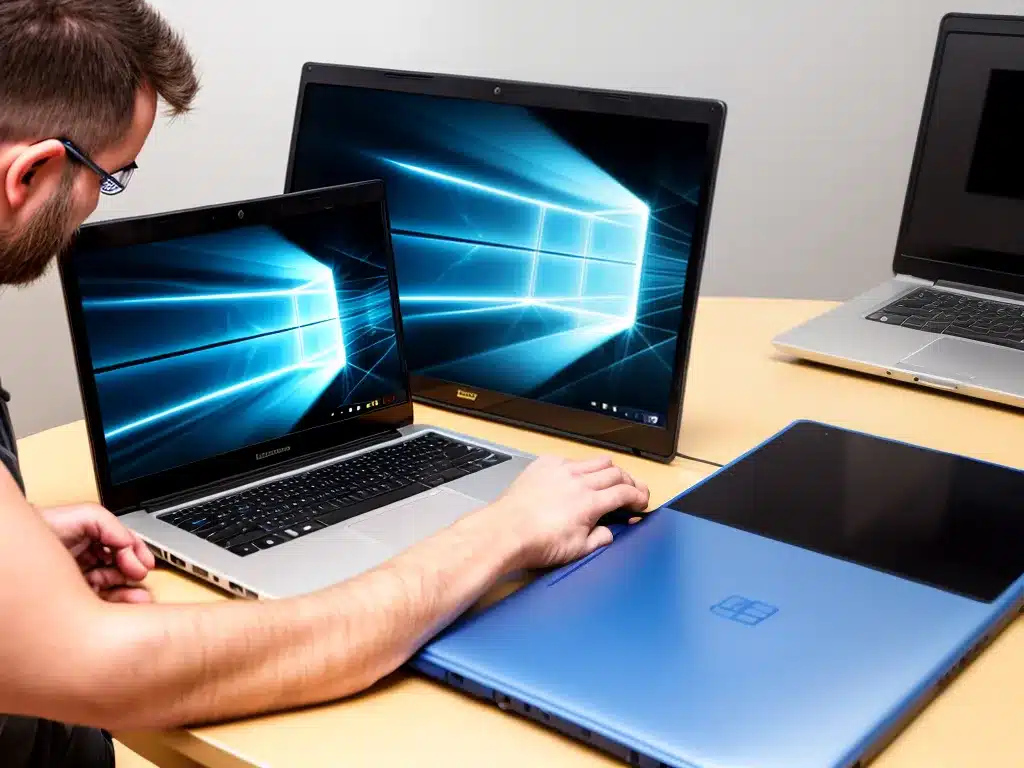
Introduction
Laptops have become an indispensable part of our lives. As someone who relies heavily on my laptop, I’m always looking for ways to extend its lifespan and get the most out of it. Proper maintenance and care is key to making your laptop last for years. In this article, I’ll share my top tips for keeping your laptop in good shape. From cleaning to upgrades, these maintenance practices will help you get the longest lifespan out of your device.
Keep It Clean
One of the most important things you can do is keep your laptop clean, both inside and out. A buildup of dust, dirt, and debris can lead to overheating and other performance issues.
Here are some cleaning tips:
-
Use compressed air to blow out dust from vents and ports every few months. This prevents dust buildup inside that can cause overheating.
-
Wipe down the exterior with a microfiber cloth to remove dirt, fingerprints, and smudges. Unplug before cleaning.
-
Use a small vacuum brush attachment to suck up dust from between keys and crevices. This removes crumbs and dirt that can damage the keyboard.
-
Clean the screen with a lint-free cloth and screen cleaner to remove smudges and allow maximum visibility. Don’t use harsh cleaners.
Regular cleaning keeps your laptop running cool and looking like new.
Upgrade Components
Upgrading certain components can give an old laptop new life. Two affordable upgrades that make a noticeable impact are:
-
Add more RAM. Additional memory allows you to run more programs simultaneously and speeds up general performance. Maximizing your laptop’s RAM capacity gives it a boost.
-
Install an SSD. Replacing a standard hard drive with a solid state drive significantly improves boot times, app launching, and data transfer speeds. It’s one of the best upgrades for an old laptop.
For power users or gamers, also consider a better CPU or graphics card. Component upgrades save you money compared to buying a new laptop.
Maintain the Battery
To extend your battery’s lifespan and ensure you get maximum usage between charges:
-
Avoid completely draining or overcharging the battery. Keep charge cycles between 20%-80% capacity.
-
Remove the battery if using your laptop plugged in for extended periods. The high heat can degrade batteries.
-
Every few months, do a full discharge to recalibrate the battery meter. Let it completely drain then fully recharge.
-
Reduce screen brightness, wifi, Bluetooth, and other power draws to conserve battery when unplugged.
With proper care, your laptop battery can retain over 80% capacity even after 1,000 charge cycles.
Update Software and Drivers
Outdated software and drivers can result in degraded laptop performance over time.
-
Keep your operating system, antivirus, and other essential software updated to the latest versions. Set automatic updates where possible.
-
Check manufacturer websites periodically for updated drivers and install them to get the full capabilities of your hardware.
-
Remove bloatware and programs you no longer use to speed up performance. A clean installation of the OS can also help.
Regular software and driver maintenance keeps your laptop running efficiently and securely.
Give It Some Rest
It’s easy to leave your laptop running all the time, but this constant use can tax the components.
-
Shut down fully when not in use rather than just putting it to sleep. This gives the hardware a chance to cool down.
-
If planning to store your laptop for an extended time, do a full shutdown first. Remove any batteries and accessories.
-
Avoid using your laptop on soft surfaces like beds or cushions that can block airflow. Keep it on a hard, flat surface.
Giving your overworked laptop frequent breaks helps it last longer.
Protect From Damage
Accidental drops, spills, or mishandling can cut your laptop’s life short. Some tips to avoid physical damage:
-
Use a padded case or sleeve when transporting your laptop. Never move it while powered on.
-
Don’t eat or drink around your device. Spills into the keyboard can cause irreparable issues.
-
Plug peripherals like external hard drives carefully to avoid port damage. Don’t overload ports.
-
Keep your laptop secure and protected when traveling to prevent theft or loss. Never check it in airline luggage.
With proper precautions, you can prevent many instances of physical damage or loss.
Know When to Let Go
Despite your best maintenance efforts, there will come a time when your laptop simply can’t keep up with modern demands. Signs it may be time to replace it include:
-
Difficulty supporting current operating systems and software
-
Components can no longer be upgraded
-
Frequent crashes, freezing, or very slow performance
-
Application load times and data transfers are extremely sluggish
-
Battery life is extremely short even with new battery
When you’ve maxed out your maintenance options, it’s best to invest in a new laptop rather than continuely dump money into an outdated one.
Conclusion
With proper care and maintenance, I’ve been able to extend the life of my laptops to 6-7 years. Putting some consistent effort into cleaning your laptop, upgrading components, maintaining the battery, keeping software updated, giving it regular rest, and protecting it from damage can keep it running smoothly for years to come. Know when repairs are no longer worth it, but otherwise a little maintenance goes a long way.












